Every coffee roaster faces the same dilemma: invest $10,000 in custom packaging or find a smarter way to build their brand.
Stock coffee bags with customizable branding zones1 offer the perfect solution. They combine the cost-effectiveness2 of pre-made bags with the brand-building power of custom labels3 and sleeves. You get professional packaging at 70% less cost than full custom orders, with minimum orders as low as 1,000 units instead of 10,000. This approach lets you test designs, adapt to market feedback, and scale gradually without tying up capital in massive inventory.
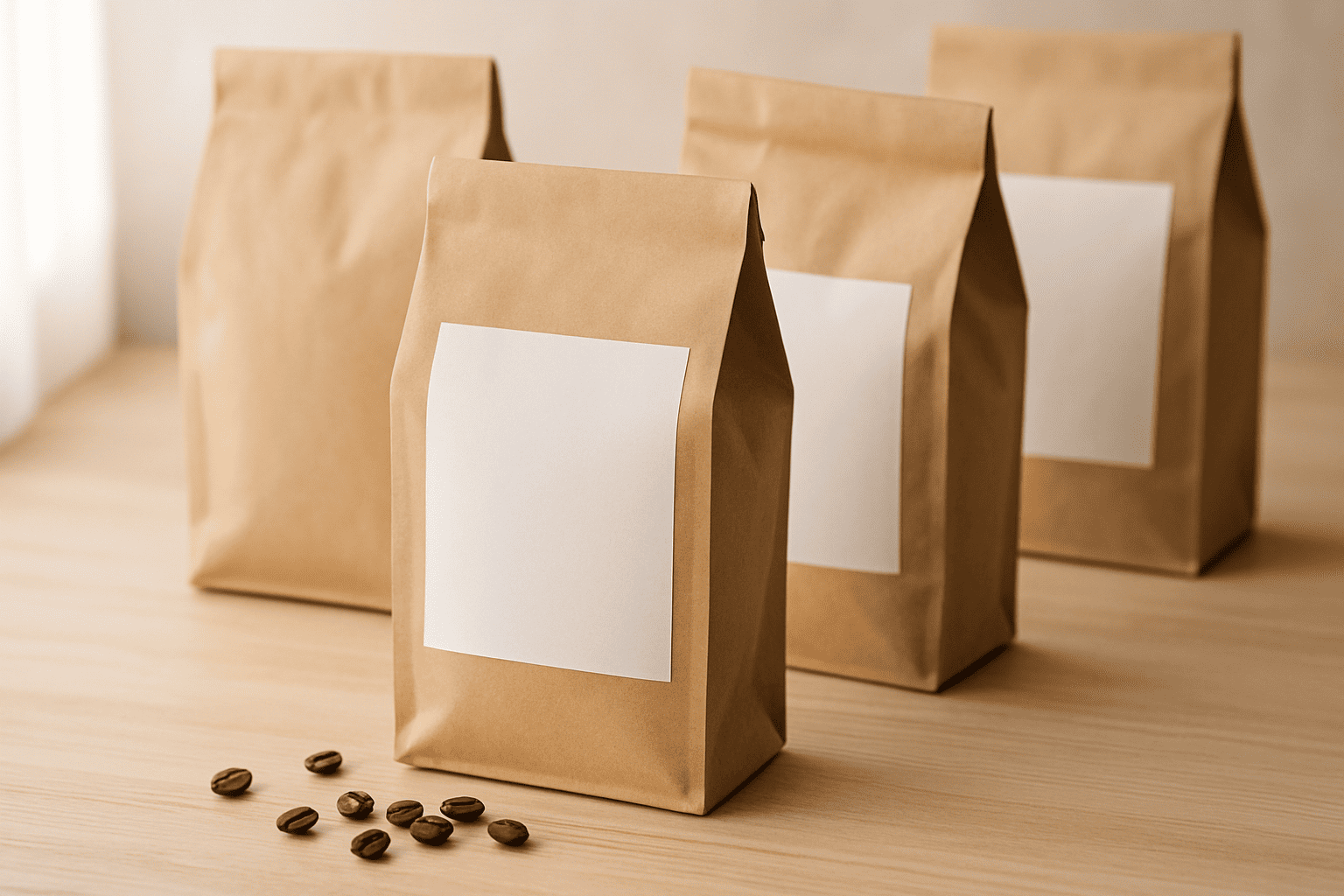
Most packaging suppliers won’t tell you this secret: the most successful coffee brands didn’t start with full custom bags. They built their reputation using stock bags with strategic branding, then upgraded once they secured stable cash flow. I’ve watched dozens of roasters follow this path to success.
What Makes Stock Coffee Bags Different from Custom Packaging?
Stock coffee bags4 seem basic at first glance, but they’re actually sophisticated packaging solutions designed for flexibility.
Stock bags are pre-manufactured pouches available in standard sizes and colors, ready for immediate shipping. Unlike custom bags that require 8-12 week production times and minimum orders of 5,000-10,000 units, stock bags ship within days with minimums as low as 1,000-2,000 units. They feature the same barrier properties, degassing valves, and resealable zippers as custom bags but without the printed graphics.
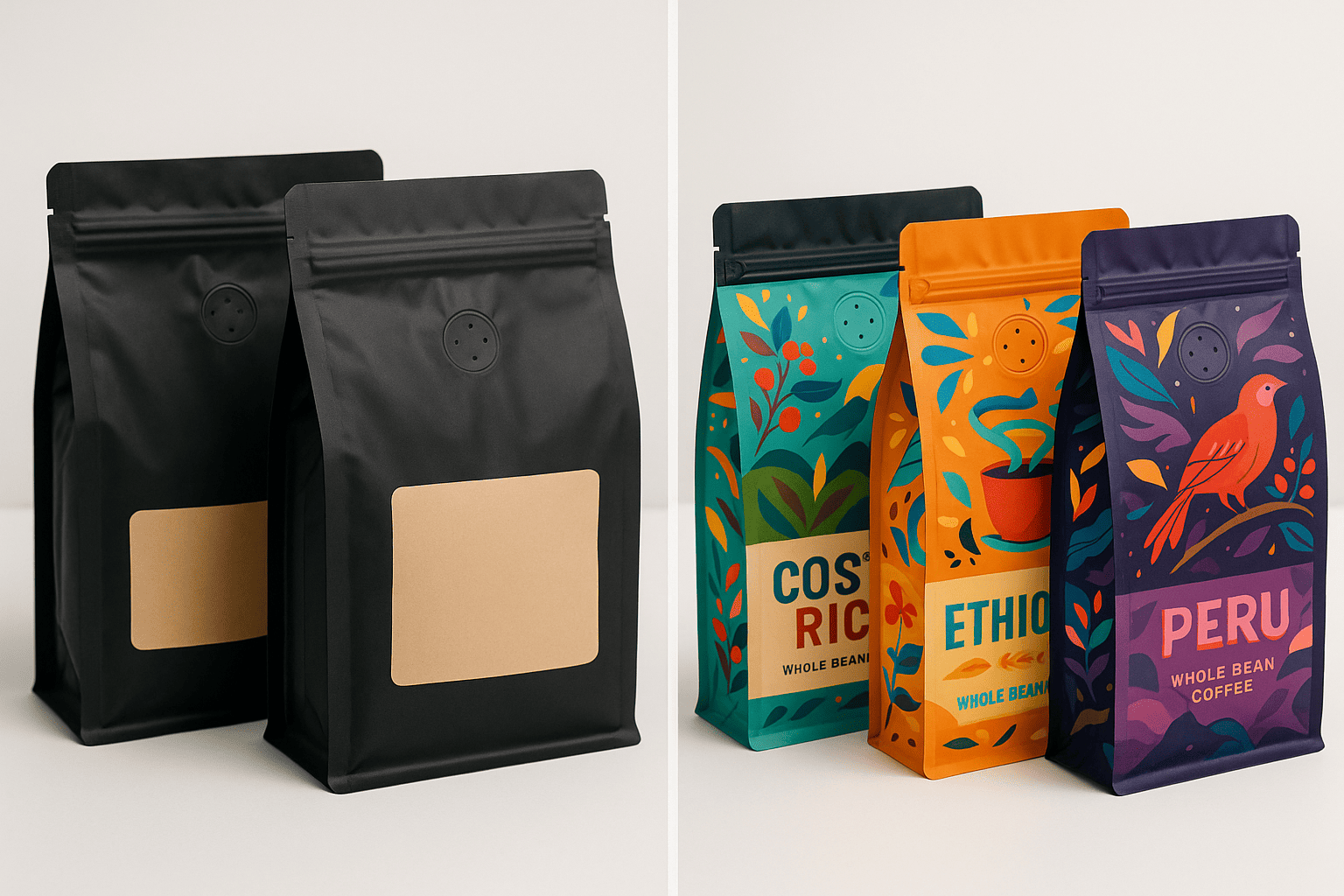
The real difference lies in how you approach branding. Custom bags lock you into one design for thousands of units. If your logo changes or you want to highlight different origins, you’re stuck with obsolete inventory. Stock bags give you complete flexibility. You can update labels weekly, test different messages, or create limited editions without waste.
I recommend starting with high-quality stock pouches in your brand colors. Black matte bags work for premium positioning5. Kraft brown suits artisanal brands. White or silver bags provide maximum label contrast. The key is choosing stock bags with smooth surfaces that accept labels cleanly. Textured surfaces can cause label lifting, especially in humid environments.
Many suppliers offer "branding zones1" on stock bags. These are designated areas optimized for label application6. Some include window panels for showcasing beans. Others feature matte patches on glossy bags specifically for labeling. These hybrid solutions cost 20% more than plain stock bags but 60% less than full custom printing.
When Should Roasters Choose Stock Bags Over Custom Printing?
The timing for stock versus custom bags depends on your business stage and cash flow situation.
Choose stock bags when you’re roasting less than 500 pounds weekly, testing new markets, launching seasonal blends7, or operating with less than $50,000 in working capital. They’re also ideal during supply chain disruptions when custom bag lead times extend beyond 16 weeks. Successful roasters use stock bags strategically even after scaling, maintaining 20% of inventory in stock bags for flexibility.
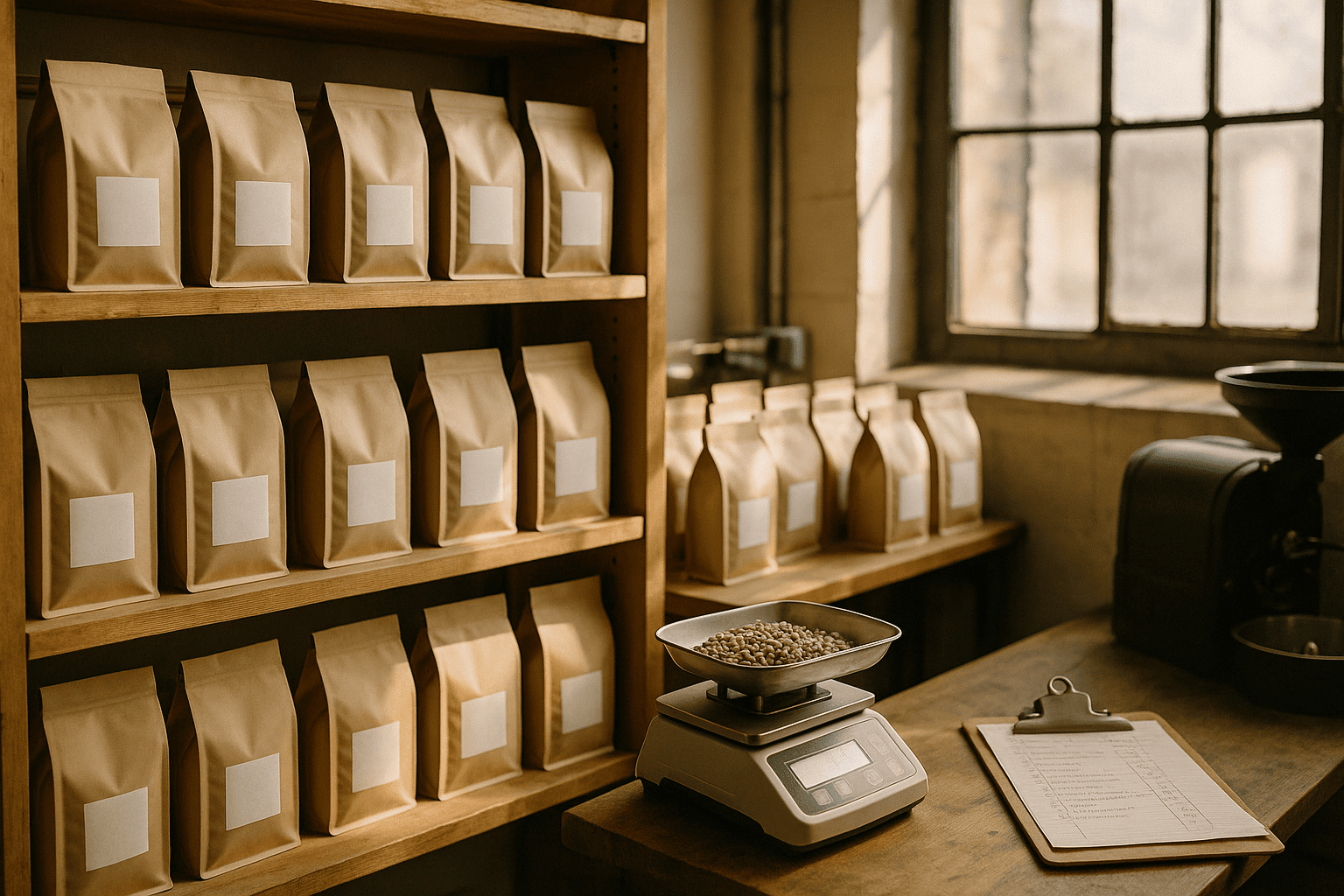
Last year, a Portland roaster came to us during the custom bag shortage. We supplied stock pouches within 72 hours, helping them fulfill a major wholesale contract they would have otherwise lost.
The financial math is compelling. Custom bags require paying upfront for thousands of units. A 10,000-unit custom order at $0.80 per bag ties up $8,000 for months. Stock bags at 500-unit minimums cost $1.20 per bag but only require $600 upfront. You sacrifice $0.40 per unit in margin but gain tremendous cash flow flexibility8.
Smart roasters use a progression strategy. Start with plain stock bags and basic labels for farmers markets. Upgrade to stock bags with professional labels for retail placement. Add belly bands9 or sleeves for premium products. Move to semi-custom bags with single-color printing. Finally, invest in full custom bags once you have predictable demand and strong cash reserves.
Seasonal and limited releases always work better with stock bags. Creating custom bags for a three-month holiday blend makes no financial sense. Stock bags with festive labels achieve the same impact without inventory risk. You can order exactly what you need, when you need it.
What Are the Hidden Benefits of Branding Stock Coffee Bags?
Beyond obvious cost savings, stock bags with custom branding offer advantages that many roasters overlook.
Stock bags enable rapid market testing10 and design iteration11 at minimal cost. You can A/B test different label designs, adjust messaging based on customer feedback, and pivot positioning without waste. This flexibility accelerates brand development. Roasters using stock bags typically finalize their brand identity 6 months faster than those locked into custom packaging12.
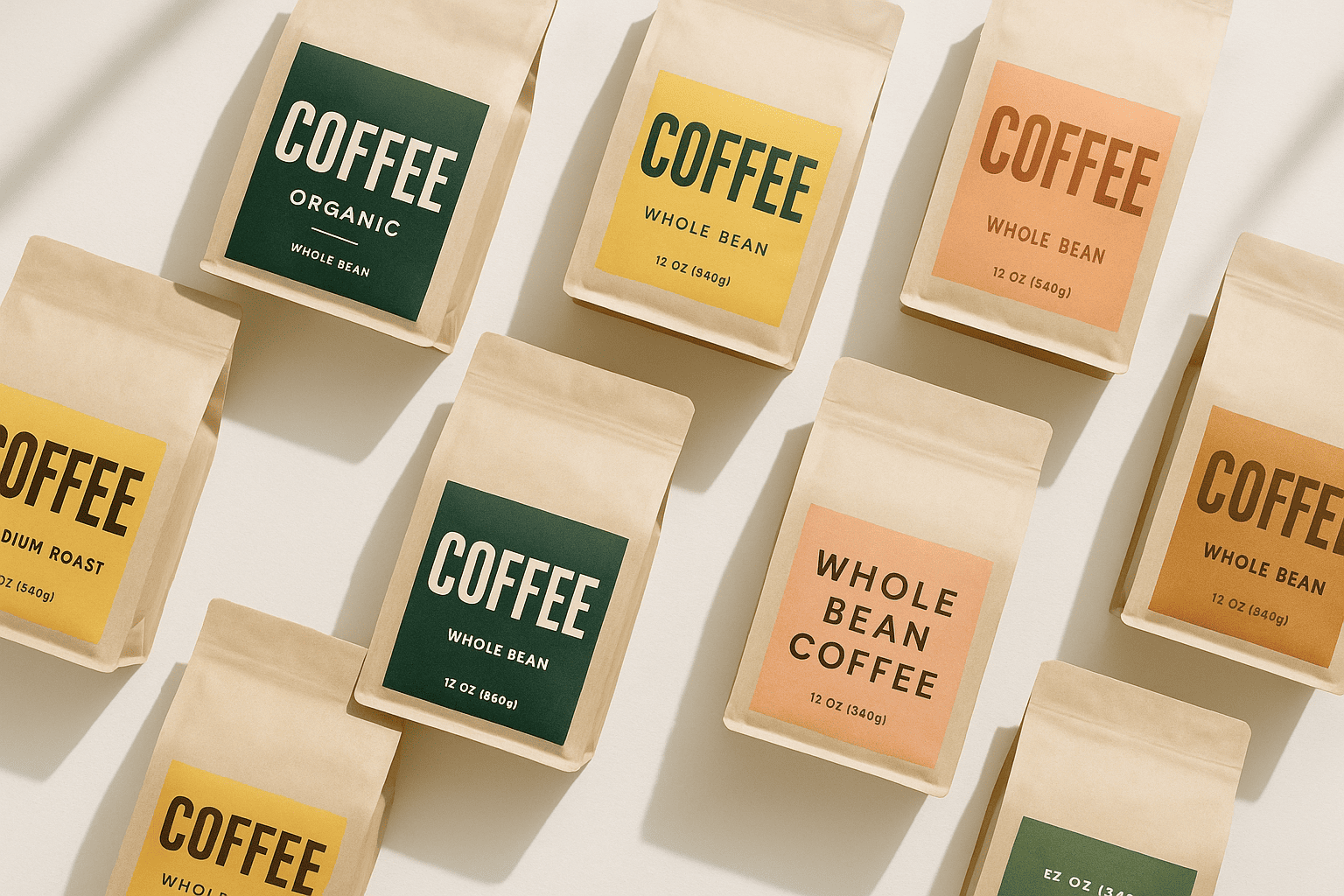
The ability to customize per batch creates storytelling opportunities. Each harvest can feature unique labels highlighting the farm, processing method, or tasting notes. Customers perceive this as artisanal attention to detail. One client increased sales 35% by adding harvest dates and farmer signatures to labels instead of printing generic bags.
Stock bags also solve the nightmare of regulatory changes13. When nutritional labeling requirements change, you update labels instead of discarding thousands of non-compliant custom bags. International orders become feasible since you can create country-specific labels without separate packaging runs.
Strategic Advantages for Growth
| Benefit | Stock Bags with Labels | Full Custom Bags |
|---|---|---|
| Minimum Order | 1,000 units | 5,000-10,000 units |
| Lead Time | 3-5 days | 8-12 weeks |
| Design Changes | Immediate | Requires new order |
| Cash Required | $800-1,500 | $8,000-30,000 |
| Storage Space | Minimal | Warehouse needed |
| Obsolescence Risk | Zero | High |
I’ve seen roasters leverage stock bags to enter new markets quickly. When a specialty grocery chain wants exclusive blends, you can deliver branded products in two weeks instead of three months. This responsiveness wins contracts that slower competitors miss.
How Can Smart Labeling Transform Basic Stock Bags?
The difference between amateur and professional stock bag branding lies entirely in label strategy14 and execution.
Professional labels transform stock bags into premium packaging through strategic design, quality materials, and precise application. Use waterproof synthetic labels with matte or gloss lamination. Include foil stamping or spot UV for luxury appeal. Position labels to create visual flow, using front labels for branding and back labels for information. Add tamper-evident seals and batch stickers for authenticity.
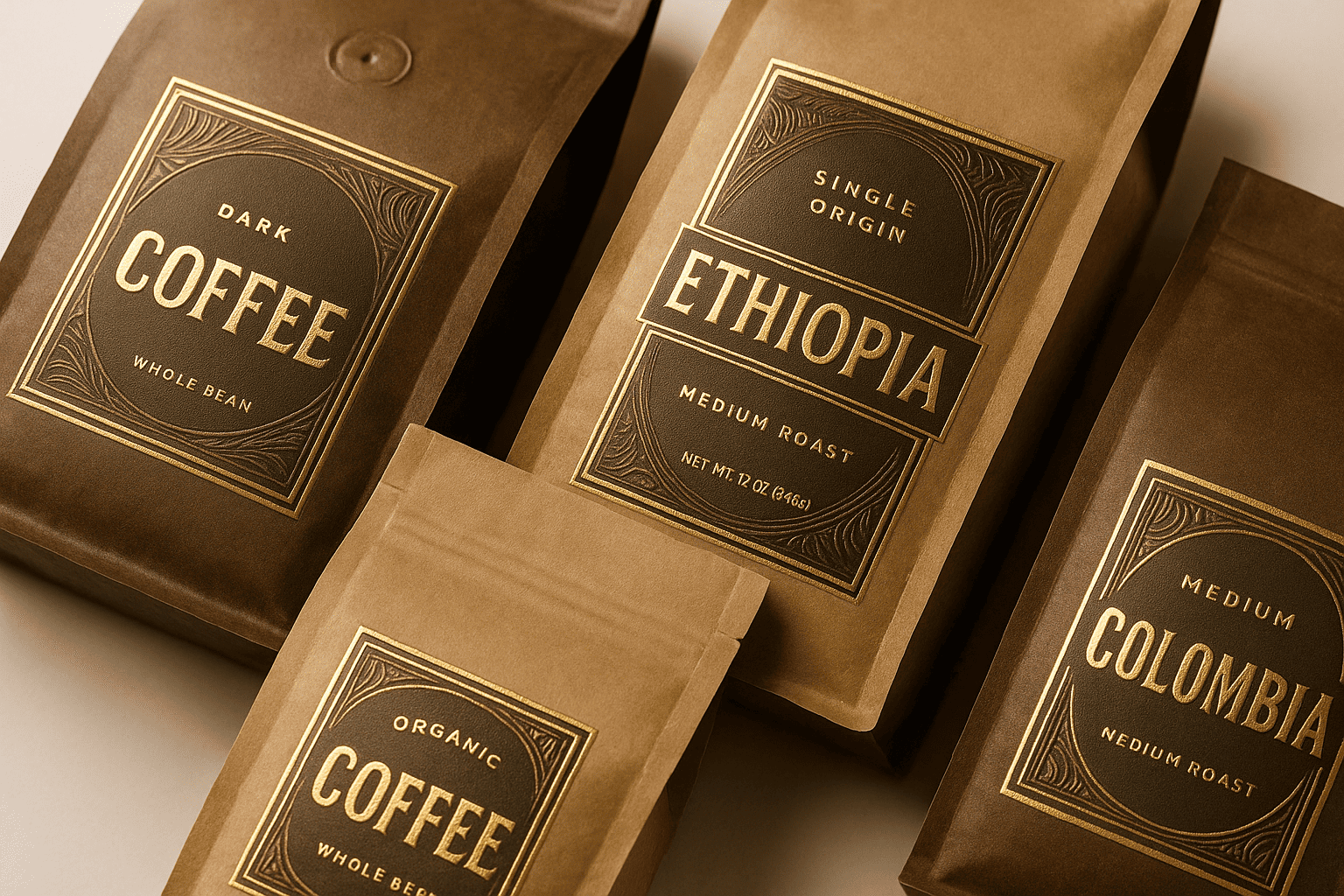
Label size matters more than most roasters realize. Oversized labels look cheap. Undersized labels get lost. The optimal ratio is 40-50% coverage of the bag face. For a standard 12oz stock pouch (5" x 8"), use 3" x 4" front labels. This leaves breathing room while maintaining visual impact.
Consider label systems15, not individual labels. Create a consistent template with variable elements. The logo and colors stay constant. Origin, roast level, and tasting notes change. This builds brand recognition while maintaining flexibility. Design costs drop 70% when you establish systems versus creating unique layouts per product.
Advanced Labeling Techniques
Belly bands add premium appeal for just $0.15 per unit. These paper wraps circle the bag middle, providing 360-degree branding space. They’re perfect for limited editions or gift sets. Remove them to reveal the standard label underneath, creating an unboxing experience.
Window labels showcase the beans while maintaining barrier properties. Apply clear labels over stock bags with windows. Include your branding on the transparent material. Customers see both your brand and product quality simultaneously.
Sustainable labeling resonates with conscious consumers. I recommend compostable labels on kraft stock bags for maximum environmental credibility. Include QR codes linking to your sustainability story. This combination increases perceived value by 25% according to my client feedback.
What Stock Bag Materials Deliver the Best Results?
Material selection determines product freshness, shelf appeal, and cost effectiveness for your specific coffee products.
For whole bean specialty coffee, choose stock bags with aluminum foil lining and one-way degassing valves. The foil provides superior oxygen and moisture barriers, maintaining freshness for 12 months. For ground coffee, prioritize multi-layer structures with enhanced barrier properties since pre-ground coffee degrades faster. Budget-conscious roasters can use kraft paper bags with poly lining for local sales with 30-day turnover.
 "Coffee bag material options comparison")
"Coffee bag material options comparison")
The thickness of stock bags16 varies significantly. Premium bags use 120-140 micron materials that feel substantial and protect contents. Budget bags at 80-100 microns work for quick turnover but may puncture during shipping. I always recommend choosing thicker materials even if they cost 20% more. Customer perception of quality starts with how the bag feels.
Sustainable materials are increasingly important but require careful selection. Compostable stock bags work well for local sales but have shorter shelf life. They typically preserve freshness for 3-6 months versus 12 months for traditional barriers. Recyclable PE structures offer a middle ground, providing 9-month shelf life with environmental benefits.
Matching Materials to Distribution Channels
| Channel | Recommended Material | Shelf Life | Cost Index |
|---|---|---|---|
| Farmers Markets | Kraft/Poly | 30 days | 1.0x |
| Local Cafes | Foil/Poly | 6 months | 1.5x |
| Retail Stores | Foil/PET/PE | 12 months | 2.0x |
| E-commerce | Extra-thick Foil | 12 months | 2.5x |
| Subscription | Compostable | 3 months | 2.2x |
Size selection often trips up new roasters. Stock bags come in standard sizes: 2oz, 4oz, 8oz, 12oz, 16oz, 2lb, 5lb. The 12oz and 2lb sizes dominate specialty coffee. Don’t try forcing 13oz of coffee into a 12oz bag to save money. Overfilled bags look unprofessional and may burst. Order samples and test fill weights before committing.
Common Questions About Stock Coffee Bags with Custom Branding
1. How much do labels cost compared to custom printing?
Professional labels cost $0.15-0.40 per unit in 1,000-unit runs. Custom bag printing adds $0.30-0.60 per unit but requires 5,000-10,000 minimum orders. Labels provide better economics until you exceed 2,000 units monthly.
2. Can stock bags with labels look as professional as custom bags?
Absolutely. Premium labels with special finishes17 on quality stock bags often look more sophisticated than basic custom printing. The key is investing in professional design and high-quality label materials.
3. What’s the ideal progression from stock to custom bags?
Start with stock bags and basic labels. Upgrade to premium labels with special finishes at 100 pounds weekly. Add belly bands9 or sleeves at 300 pounds weekly. Consider custom bags only after reaching 500 pounds weekly with stable demand.
4. How do I prevent labels from peeling off?
Use synthetic waterproof labels with permanent adhesive. Ensure bags are clean and dry before application. Avoid applying labels over valves or seams. Store labeled bags below 70°F and 50% humidity.
Conclusion
Stock coffee bags with custom branding offer the perfect balance of flexibility, affordability, and professional appearance for growing coffee roasters. They enable rapid market entry, design testing, and gradual scaling without the massive capital requirements of custom packaging12. Smart roasters use this approach to build strong brands while maintaining the cash flow needed for growth.
-
Understand the concept of branding zones and how they can optimize your packaging. ↩ ↩
-
Discover cost-effective packaging solutions that can help your coffee business thrive. ↩
-
Find out how custom labels can elevate your coffee brand’s visibility and appeal. ↩
-
Explore how stock coffee bags can enhance your branding strategy while saving costs. ↩
-
Explore how effective packaging can enhance the premium perception of your coffee brand. ↩
-
Discover best practices for applying labels to ensure a professional appearance. ↩
-
Discover how stock bags can effectively showcase seasonal blends without inventory risk. ↩
-
Learn why maintaining cash flow flexibility is crucial for the growth of your coffee business. ↩
-
Explore how belly bands can add a premium touch to your coffee packaging. ↩ ↩
-
Explore how stock bags allow for rapid market testing and design iteration. ↩
-
Explore how design iteration can enhance your coffee bag branding and customer engagement. ↩
-
Learn the differences between custom packaging and stock options to make informed decisions. ↩ ↩
-
Find out how stock bags can adapt to regulatory changes without incurring losses. ↩
-
Understand how a well-thought-out label strategy can transform your coffee packaging. ↩
-
Understand how label systems can streamline your branding process and reduce costs. ↩
-
Find out how the thickness of stock bags affects product quality and customer perception. ↩
-
Discover how special finishes can elevate the look of your coffee bag labels. ↩

